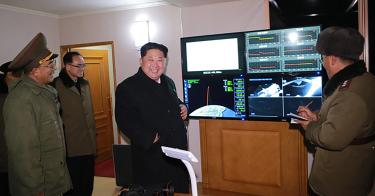After a hiatus of two-plus months, North Korea went ballistic again this week with the test launch of a new intercontinental ballistic missile, ICBM — the Hwasong-15.
It may be capable of striking all of the United States.
Based on initial reported estimates, this latest ICBM appears to have the longest range yet, exceeding that of the two previous North Korean Hwasong-14 ICBM tests over the summer.
As in past ICBM shots, Pyongyang sent the mobile Hwasong-15 sharply skyward, reportedly causing the missile to fly to an altitude of nearly 3,000 miles while only traveling about 600 miles across the Earth’s surface during its nearly one-hour flight.
A flatter trajectory would send the ICBM much, much farther.
The launch also came in the middle of the night, at about 3 a.m. “Pyongyang time,” according to news reports, which is 13.5 hours ahead of us. (In 2015, North Korea created its own time zone, shifting its clocks back 30 minutes.)
The nighttime test could have been done for a couple of reasons, including preventing prying “eyes in the sky” (that is, satellites) from viewing launch preparations, trying to create the element of surprise or simulating a wartime scenario.
The missile reportedly landed in the Sea of Japan off the Korean Peninsula, splashing down within 200 miles of Japan, according to officials in Tokyo. The launch, which U.S. sensors probably detected immediately, clearly wasn’t a direct military threat to the United States, American territory (like Guam) or U.S. forces.
This time, that is.
Indeed, news accounts report that the South Korean government stated shortly before the launch in a public forum that North Korea might have a fully-operational, nuclear ICBM sometime next year.
If correct, that would mean that Pyongyang has been able to solve difficult technical issues related to nuclear warhead development such as surviving the environmental stresses (such as G-forces, heat and vibration) of ICBM flight and atmospheric reentry.
North Korea claimed that the Hwasong-15 carried a “super-large, heavy” warhead, which could be true. The reason it’s important is that the weight of the warhead atop the ICBM will affect the distance the missile can travel.
Nuclear warheads are heavy and if the dummy warhead on the Hwasong-15 was light, it could mean that this test didn’t really demonstrate the ability to reach the United States’ East Coast. Pyongyang clearly wants to convince us otherwise.
But this latest launch doesn’t mean “game-over” for us.
Yes, work on fielding an operational nuclear ICBM force significantly increases the threat to our national security — and we should continue attempting to dissuade Pyongyang from this path.
Indeed, there are still questions regarding the North Korean ICBM program beyond nuclear warhead development and missile range and accuracy that are important to policy development should diplomatic and punitive economic efforts fail.
For instance, key strategic issues include estimates on the future size of North Korea’s nuclear arsenal. In other words, will it build one or 100 ICBMs? Then there’s strategic intent: Are these missiles for attacking the U.S. first or to deter us from attacking them first?
These are central questions, among others, that we must seek to understand as we go forward in developing our response to Pyongyang’s latest provocation — and the ones to come.
This piece originally appeared in Boston Herald



